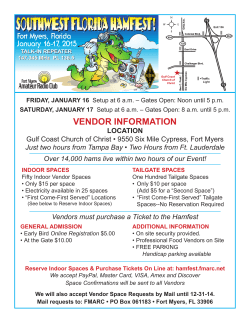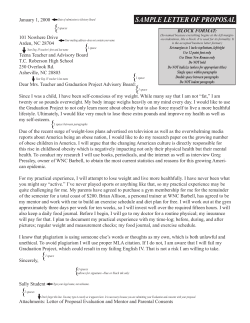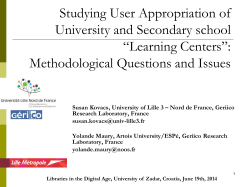
Engineering Statistics PROBABILITY
Engineering Statistics
GE 3201
Second Term 2014 -2015
Chapter 2
PROBABILITY
Instructors:
Dr. Khaled AbuHasel
Dr. Khaled M. Soliman
Mechanical Engineering Department
Industrial Engineering Program
College of Engineering
Department of Mechanical Engineering
Industrial Engineering Program
Sample Spaces and Events
2-1.1 Random Experiments
Definition
2-1.2 Sample Spaces
Definition
2
College of Engineering, IE Program
Second Term 2014 2015
Sample Spaces and Events
2-1.2 Sample Spaces
Example 2-1
3
College of Engineering, IE Program
Second Term 2014 2015
Sample Spaces and Events
Example 2-1 (continued)
4
College of Engineering, IE Program
Second Term 2014 2015
Sample Spaces and Events
Example 2-2
5
College of Engineering, IE Program
Second Term 2014 2015
Sample Spaces and Events
Example 2-2 (continued)
6
College of Engineering, IE Program
Second Term 2014 2015
Sample Spaces and Events
Tree Diagrams
• Sample spaces can also be described graphically with tree diagrams.
When a sample space can be constructed in several steps or stages, we can
represent each of the n1 ways of completing the first step as a branch of a
tree.
Each of the ways of completing the second step can be represented as n2
branches starting from the ends of the original branches, and so forth.
7
College of Engineering, IE Program
Second Term 2014 2015
Sample Spaces and Events
Figure 2-5 Tree diagram for three messages.
8
College of Engineering, IE Program
Second Term 2014 2015
Sample Spaces and Events
Example 2-3
9
College of Engineering, IE Program
Second Term 2014 2015
Sample Spaces and Events
2-1.3 Events
Definition
10
College of Engineering, IE Program
Second Term 2014 2015
Sample Spaces and Events
2-1.3 Events
Basic Set Operations
11
College of Engineering, IE Program
Second Term 2014 2015
Sample Spaces and Events
2-1.3 Events
Example 2-6
12
College of Engineering, IE Program
Second Term 2014 2015
Sample Spaces and Events
Definition
13
College of Engineering, IE Program
Second Term 2014 2015
Sample Spaces and Events
Venn Diagrams
Figure 2-8 Venn diagrams.
14
College of Engineering, IE Program
Second Term 2014 2015
Interpretations of Probability
2-2.1 Introduction
Probability
• Used to quantify likelihood or chance
• Used to represent risk or uncertainty in engineering
applications
• Can be interpreted as our degree of belief or relative
frequency
15
College of Engineering, IE Program
Second Term 2014 2015
Interpretations of Probability
Equally Likely Outcomes
16
College of Engineering, IE Program
Second Term 2014 2015
Interpretations of Probability
Example 2-15
17
College of Engineering, IE Program
Second Term 2014 2015
Interpretations of Probability
Figure 2-11 Probability of the event E is the sum of the
probabilities of the outcomes in E
18
College of Engineering, IE Program
Second Term 2014 2015
Interpretations of Probability
Definition
19
College of Engineering, IE Program
Second Term 2014 2015
Interpretations of Probability
Example 2-16
20
College of Engineering, IE Program
Second Term 2014 2015
Interpretations of Probability
2-2.2 Axioms of Probability
21
College of Engineering, IE Program
Second Term 2014 2015
Addition Rules
Probability of a Union
Mutually Exclusive Events
22
College of Engineering, IE Program
Second Term 2014 2015
Addition Rules
Three Events
23
College of Engineering, IE Program
Second Term 2014 2015
Addition Rules
Example 2-21
24
College of Engineering, IE Program
Second Term 2014 2015
Example 2-19
The following table lists the history of 940 wafers in a
semiconductor manufacturing process. Suppose one
wafer is selected at random.
Calculate the probability that a wafer is from the center
of the sputtering tool or contains high levels of
contamination (or both).
25
College of Engineering, IE Program
Second Term 2014 2015
Problem 2-67
26
College of Engineering, IE Program
Second Term 2014 2015
Conditional Probability
• To introduce conditional probability, consider an example
involving manufactured parts.
• Let D denote the event that a part is defective and let F
denote the event that a part has a surface flaw.
• Then, we denote the probability of D given, or assuming,
that a part has a surface flaw as P(D|F). This notation is
read as the conditional probability of D given F, and it is
interpreted as the probability that a part is defective, given
that the part has a surface flaw.
27
College of Engineering, IE Program
Second Term 2014 2015
Conditional Probability
Figure 2-13 Conditional probabilities for parts with
surface flaws
28
College of Engineering, IE Program
Second Term 2014 2015
Example 2-22
The following table provides an example of 400 parts
classified by surface flaws and as defective:
28
29
College of Engineering, IE Program
Second Term 2014 2015
Conditional Probability
Definition
30
College of Engineering, IE Program
Second Term 2014 2015
Conditional Probability
31
College of Engineering, IE Program
Second Term 2014 2015
Conditional Probability
Example: consider the previous example
32
College of Engineering, IE Program
Second Term 2014 2015
Conditional Probability
Another solution
33
College of Engineering, IE Program
Second Term 2014 2015
Example
§ An article in IEEE application in Power (April 1990) describes “an unmanned
watching system to detect intruders in real time without spurious (false)
detection, both indoors and outdoors, using video cameras and
microprocessors”. The system was tested outdoors under various weather
conditions in Tokyo, Japan. The number of intruders detected and missed
under each condition are provided in the following table:
Weather Conditions
Clear
Cloudy
Rainy
Snowy
Windy
Intruders detected
21
228
226
7
185
Intruders missed
0
6
6
3
10
Total
21
234
232
10
195
34
College of Engineering, IE Program
Second Term 2014 2015
Example
•
•
Under cloudy conditions, what is the probability that the unmanned
system detects an intruder?.
Given that the unmanned system missed detecting an intruder,
what is the probability that the weather condition was snowy?.
1.Define the following events:
A: {Cloudy conditions}
B: {Unmanned system detects an intruder}
From table,
234
21+ 228 + 226 + 7 + 185 667
228
, P( B) =
=
, P(A I B) =
692
692
692
692
P( A I B) 228/ 692
P( B l A) =
=
= 0.974
P(A)
234 / 692
P(A) =
35
College of Engineering, IE Program
Second Term 2014 2015
Example
2. Define the following events:
C: {Snowy conditions}
From table,
10
667 25
3
=
, P( B¢) = 1 - P( B) = 1 , P( B¢ I C) =
692
692 692
692
P( B¢ I C) 3 / 692
=
= 0.12
P(C l B¢) =
P( B¢)
25 / 692
P(C) =
36
College of Engineering, IE Program
Second Term 2014 2015
Multiplication and Total Probability
Rules
2-5.1 Multiplication Rule
37
College of Engineering, IE Program
Second Term 2014 2015
Multiplication and Total Probability Rules
Example 2-26
38
College of Engineering, IE Program
Second Term 2014 2015
Multiplication and Total Probability Rules
2-5.2 Total Probability Rule (two events)
39
College of Engineering, IE Program
Second Term 2014 2015
Multiplication and Total Probability Rules
Example 2-27
40
College of Engineering, IE Program
Second Term 2014 2015
Multiplication and Total Probability Rules
Total Probability Rule (multiple events)
41
College of Engineering, IE Program
Second Term 2014 2015
Example 2-28
42
College of Engineering, IE Program
Second Term 2014 2015
Independence
Definition (two events)
Definition (multiple events)
43
College of Engineering, IE Program
Second Term 2014 2015
Example 2-34
44
College of Engineering, IE Program
Second Term 2014 2015
Counting Rules
§ A product can be shipped by four different airlines, and
each airline can ship via three different routes. How
many distinct ways exist to ship the product?.
Route
1
2
3
1
2
3
1
2
There are (4) * (3) = 12 distinct
ways exist to ship the product
3
1
2
3
45
College of Engineering, IE Program
Second Term 2014 2015
Multiplicative Rule Counting
Techniques
46
College of Engineering, IE Program
Second Term 2014 2015
Example
§ Consider an experiment of tossing a coin 10 times.
Calculate the number of simple events.
Solution
There are k=10 sets of elements. Each set contains two
elements (a head and a tail), thus
Number of simple events =
(2) (2) (2) (2) (2) (2) (2) (2) (2) (2) = (2)
= 1024 different outcomes
47
College of Engineering, IE Program
Second Term 2014 2015
Example
Solution
48
College of Engineering, IE Program
Second Term 2014 2015
Permutation
§ Suppose
there are five flights to be scheduled,
each requiring one pilot. Assuming that no pilot
can go no more than one flight, in how many
different ways can five of the company’s 100 pilot
can be assigned to the flight?
Solution
100
99
98
97
96
(100)(99)(98)(97)(96) = 9,034,502,400
The arrangement of elements in distinct order is called
a Permutation
49
College of Engineering, IE Program
Second Term 2014 2015
Permutation
50
College of Engineering, IE Program
Second Term 2014 2015
Permutation
Where
n! = n(n-1)(n-2)……..(3)(2)(1) and is called factorial
Note: 0! = 1
51
College of Engineering, IE Program
Second Term 2014 2015
Example
§ You
want to drive, in sequence, from a starting point to each of
five cities, and you want to compare the distances and average
speeds of the different routings. How many different routings
would have to be compared?.
§ Solution
§The
total number of routings would be the number of ways you
could arrange.
The n = 5 cities, in r = 5 positions. This number is
5
P
5
=
( 5
5 !
- 5 )!
=
5 !
0 !
=
52
5 . 4 . 3 . 2 . 1
1
=
120
College of Engineering, IE Program
Second Term 2014 2015
Permutation of Similar Objects
53
College of Engineering, IE Program
Second Term 2014 2015
Example 2-11
54
College of Engineering, IE Program
Second Term 2014 2015
Example
§ You have 12 systems analysts and you want to assign three to job 1,
four to job 2, and five to job 3. in how many ways you can make this
assignment?
§ Solution
12 !
= 27 , 720
3! 4 !5 !
55
College of Engineering, IE Program
Second Term 2014 2015
Combinations
Note:
• The order in which the n elements are drawn is
not important, and
• There are less combinations than permutations
56
College of Engineering, IE Program
Second Term 2014 2015
Example
§ Five
sales engineers will be hired from a group of 100
applicants. In how many ways can groups of five sales
engineers be selected?
§ Solution
100 !
5 ! ( 100 - 5 )!
= 45 , 287
57
, 520
College of Engineering, IE Program
Second Term 2014 2015
Example 2-13
Solution
58
College of Engineering, IE Program
Second Term 2014 2015
Bayes’ Theorem
Definition
Bayes’ Theorem
59
College of Engineering, IE Program
Second Term 2014 2015
Example 2-37
60
College of Engineering, IE Program
Second Term 2014 2015
Example
§ Consider an assembly plant, where three machines B1,
B2, and B3 make 30%, 45%, and 25% respectively, of
the products.
§ From past experience, it is known that:
§ 2% of the parts made by machine B1 are defective.
§ 3% of the parts made by machine B2 are defective.
§ 2% of the parts made by machine B3 are defective.
§A
product was randomly and it was found to be
defective, what is the probability that it was made by
machine B3?.
61
College of Engineering, IE Program
Second Term 2014 2015
Example
P(B1)
Product
B1
P(A\B1)
Defective Product
0.02
0.3
P(B2)
0.45
B2
P(B3)
0.25
B3
P(A\B2)
Defective Product
0.03
P(A\B3)
Defective Product
0.02
P(B3\A) = ???
62
College of Engineering, IE Program
Second Term 2014 2015
Example
P(B3 I A )
P(A )
P(B3 I A ) = P(A I B3 ) = P(B3 )P(A \ B3 )
P(B3 \ A ) =
P ( A ) = P ( B1 ) P ( A \ B1 ) + P ( B 2 ) P ( A \ B 2 ) + P ( B 3 ) P ( A \ B 3 )
P(B3 \ A ) =
P(B3 )P(A \ B3 )
P ( B1 ) P ( A \ B1 ) + P ( B 2 ) P ( A \ B 2 ) + P ( B 3 ) P ( A \ B 3 )
P(B3 \ A ) =
( 0 . 25 )( 0 . 02 )
=
( 0 . 3 )( 0 . 02 ) + ( 0 . 45 )( 0 . 03 ) + ( 0 . 25 )( 0 . 02 )
63
College of Engineering, IE Program
Second Term 2014 2015
Random Variables
Definition
64
College of Engineering, IE Program
Second Term 2014 2015
Random Variables
Definition
65
College of Engineering, IE Program
Second Term 2014 2015
Random Variables
Examples of Random Variables
66
College of Engineering, IE Program
Second Term 2014 2015
© Copyright 2025










